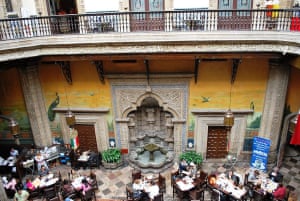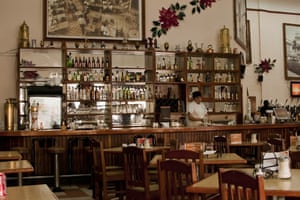‘The history of a city is the history of its cafs’: writing life in Mexico

Finding the old coffeehouses among the American chains in Mexico City is hard, says author and journalist Juan Villoros, but they’re wonderful spaces to write in when you find one.

Built over a lake that was drained, overwhelmed by the exhaust of cars and the pollution in a valley encircled by mountains that don’t let the wind in, Mexico City is a bastion of dust mites. The atmosphere isn’t as aggressive as our winter is benevolent (although you suffer inside the houses, built according to the superstitious idea that heat is unnecessary), but spring asthenia thrives in the dirty air. The arrival of the rains, more torrential all the time, provides relief from allergies but not from flooding.
In this context cafs are not, as in other parts of the world, places where you can escape the snow for a while, but rather spots where you can combat the rush and, in some cases, breathe differently. Some modern coffeehouses have a system known as washed air; the more traditional ones dont have it and dont need it: they make up for the vapors of the Italian machine with a fan that simultaneously refreshes the air. The best atmosphere in Mexico City is in a caf.
In my adolescence people spoke of caf intellectuals, not with the respect due to a sect that transmits ideas within the cramped space of a table but with the contempt reserved for those who turn their backs on reality and take refuge in vain speculation.
Nonetheless, the elusory cafs of Mexico City represented singular refuges for reinventing the real with words.
There have never been many cafs in Mexico City. If you don’t count the spots started by Cubans and Spaniards in the centro, among us the caf has never occupied the preeminent place it has in other metropolises. What’s more, the North American-style chains have bit by bit replaced the little cafs where the owner would smoke behind the counter with a dog on a comfortable cushion at his side the unique, unrepeatable places, the grottos of the initiates.
The capitals best-known caf is the Casa de los Azulejos, or House of Tiles, built by a revanchist Spaniard looking to get back at the authoritarian father who had told him, You won’t even be able to build a house of tiles (meaning a toy house). The stately building has a mural by Jos Clemente Orozco in its staircase. Upstairs there’s a bar with a little window in the shape of a flower which gives onto one of the best views of the centro histrico, dominated by domes and bell towers.

The invasion of plastic-chair coffee shops lent the few real cafs an air of quasi-secrecy. Meeting spots for a sect to which one belongs on merits that can’t always be defined.
A caf is a place for talking. The mythology of radio announcers, who populated my childhood with magic words, was substituted in my enthusiasm by that of writers, particularly poets. Going on twenty, Id make pilgrimages down Bucareli towards Caf La Habana, where according to Roberto Bolao the iron poets could be found.
Mario Santiago Papasquiaro: I met him in 1973 under his original name, Jos Alfredo Zendejas, in a short story workshop. He wrote only poems but liked to debate narrative. His critical sense was ferocious, yet he tempered his fire with jokes that he himself celebrated with thunderous guffaws. He had read more than we had, knew the avant-gardes; had banged the drum, along with Roberto Bolao and other rebels, for infrarrealismo; and was planning an epic trip to Europe.
People treated him with annoyed suspicion. When hed come to see me at La Jornada, the newspaper where I worked, the receptionist, who was used to dealing with all kinds of eccentrics, would call me on the phone to ask whether I really wanted to let Mario in. I preferred to see him at Caf La Habana, where hed order a beer at ten in the morning in order to evoke the 1970s, the period Bolao was to make famous in The Savage Detectives, where Mario appears under the name Ulises Lima.

The rhythm of a caf lends itself to the writing and correcting of verses that roll onward as the cigar smoke once did. You cant write a novel in a caf.
The urgent demands of journalism and the need for isolation drove me away from cafs, where I had begun to feel superfluous. I wasnt a poet and was wasting time. So said my puritanical conscience, trained at the Colegio Alemn.
Sometimes I take shelter from the rain in those places and kill time there between one appointment and the next, but theyre no longer targets in my life. I admire the people who get together there, although I do it with the incongruous feeling of one whos been missing out on something for thirty years. Every city has parallel societies: the gamblers, beggars, drug dealers and addicts tend to associate clandestinely in order to fraternize at the margins of the norm. For me cafs have become something similar, almost prohibited. Is there any reason for this renunciation? Its possible that it all has to do with the way we administer the future. For years Id meet with poets to talk about the future. I didnt plan to write any poems, but like the protagonists of On the Road or The Savage Detectives, I aspired to live poetically. The caf was the place of violent conjecture, the place where we could conceive of rare, perhaps unattainable hopes.
The history of a city is the history of its cafs, where life mixes with culture. Ramn Gmez de la Serna set up his observation post at the Pombo in Madrid, Claudio Magris his at the San Marco in Trieste; Karl Kraus at the Central in Vienna; Jean-Paul Sartre at the Deux Magots in Paris; Fernando Pessoa at the Martinho da Arcada in Lisbon; Juan Rulfo at the gora in Mexico City.
Is there any better way to get to know a city in a sedentary key? If the walking man deciphers the lay of the land by looking, the man of the caf understands his time by listening. Coffeehouses afforded me a valuable exercise: being in the city without being absorbed by it, seeing others at the moment when they excuse themselves from their habitual codified conduct. The urban custom they turn to most often in that enclosure is a certain type of conversation, one that foregoes conclusions and aspires only to continuation.
The infinite needs strategies in order to become intimate. Mexico City is inexhaustible in a provisional way, like a cup of caf cortado.
About the Author
- Juan Villoro is the author of El testigo, Dios es redondo (God is Round), Los culpables (The Guilty), and other books. His journalistic and literary work has been recognized with such international prizes as the Herralde de Novela, Premio Xavier Villaurrutia, Rey de Espaa, Ciudad de Barcelona, Vzquez Montalbn de Periodismo Deportivo, and Antonin Artaud. He has been a professor of literature at UNAM, Yale, and la Universidad Pompeu Fabra de Barcelona. He is a columnist for the newspapers Reforma and El Peridico de Catalunya.
About the Translator
- Philip K. Zimmerman is a writer and a translator from Spanish and German. Born in Madrid, he was raised in Upstate New York. His work has been included in the Berlin International Literature Festival and the New York International Fringe Festival, and he recently completed a translation of Helene and Wolfgang Beltracchis autobiography, Selbstportrt (Self-Portrait). He lives in Munich, Germany.
This essay is excerpted from Juan Villoros El vrtigo horizontal: la Ciudad de Mxico.